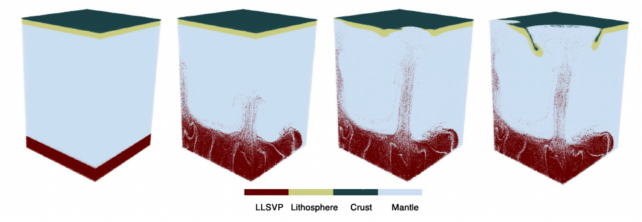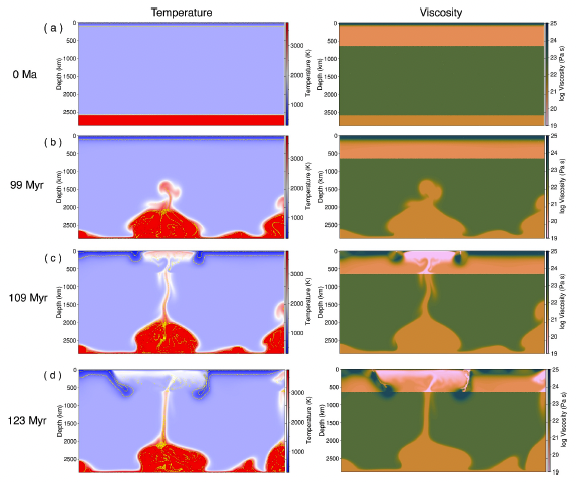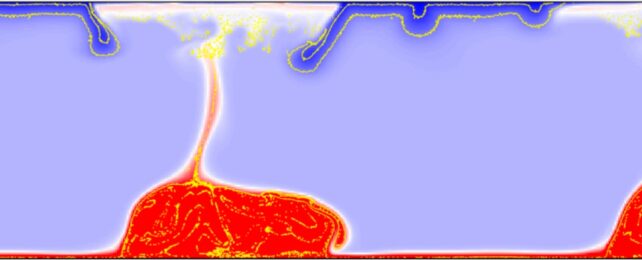On the scale of benign to cataclysmic events, the whomping impact of a Mars-sized object that crashed into Earth some 4.5 billion years ago ranks pretty highly: thought to have set in motion the movement of our planet's fractured, rocky crust, new research suggests.
The impact of Theia, the thumper in question, is also thought from previous work to have ejected debris that coalesced into the Moon and seeded Earth with essential elements for life. But its possible role in creating tectonic plates, the chunks of crust that bob atop our planet's sludgy mantle, is far less certain.
Only last year did scientists detect evidence of what they suspect with greater confidence are remnants of Theia inside Earth to match those inside the Moon.
First found in the 1980s, these continent-sized blobs located beneath the Pacific Ocean and Africa were previously thought to be either temperature hotspots, a magma 'ocean' deep beneath our watery ones, or old, sunken tectonic plates. Those scenarios were thought more plausible than remnants of Theia surviving billions of years in a churning mantle.
Now, a new study from researchers at the California Institute of Technology (Caltech) suggests that Theia might be the reason for the turbulence of that very mantle and the movement of tectonic plates on its surface.
"The giant impact is not only the reason for our moon, if that's the case, it also set the initial conditions of our Earth," Caltech geoscientist Qian Yuan, who led the study, told The Washington Post.
After leading the 2023 study describing how part of Theia could have sunk towards Earth's core after impact and survived to the present day, Yuan and his Caltech colleagues set about understanding what happened next.
Past evidence suggests mechanisms in early Earth's mantle that kicked off subduction, the geological process where one tectonic plate sinks under another into the mantle below, began just 200 million years after Theia's purported impact – so soon that scientists had wondered how.
"In this study, we perform whole‐mantle convection models to illustrate that strong mantle plumes can arise, weaken the lithosphere, and eventually initiate subduction [about] 200 million years after the giant impact," Yuan and colleagues explain in their published paper.

These plumes, the team's simulations suggest, were created primarily by the increase in temperature at the core-mantle boundary of early Earth as a result of parts of Theia that accumulated there.
Another potential contributor was the blobs themselves, which are iron-rich and dense. If indeed they are buried relics of Theia, as Yuan's 2023 study suggests, then they likely resemble the geological content of Mars and contain more heat-producing elements than the surrounding mantle in which they sit.
The heat emanating out of the blobs could have given rise to strong plumes that likely continued to trigger transient episodes of subduction as the core-boundary cooled, the researchers found. This squares with earlier research suggesting plate tectonics started with mantle upwellings.

So it seems Theia had a lasting impact, shaping Earth's geological evolution from the inside out. According to Yuan and colleagues, their findings exemplify "the pivotal influence of initial conditions set by giant impact processes for the tectonic evolution of terrestrial planets."
But not all geologists agree. Some have questions about how such a violent collision could have stirred up Earth's mantle without recycling the whole crust.
Past research has also suggested that tectonic plates formed by entirely different processes: either Earth heated up and expanded to the point its crust cracked or, in another wild suggestion, our planet's rocky surface was ripped apart by gravitational forces.
Just like the theory of plate tectonics is still being refined, so too will this one about how those plates first formed.
The research has been published in Geophysical Research Letters.
